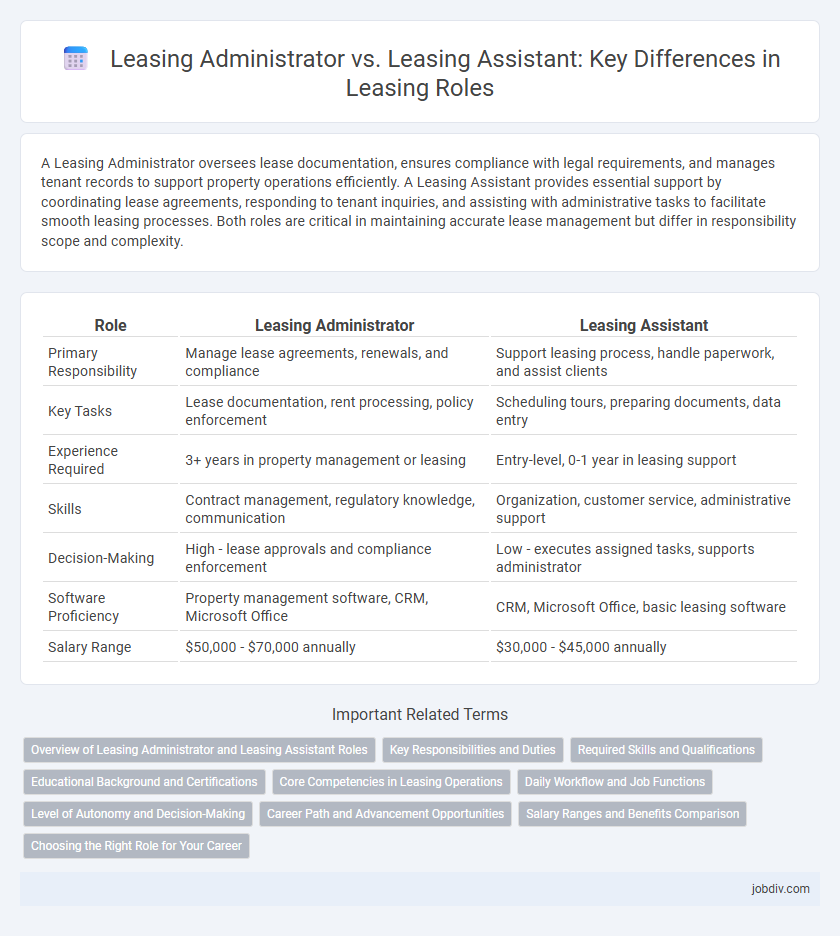A Leasing Administrator oversees lease documentation, ensures compliance with legal requirements, and manages tenant records to support property operations efficiently. A Leasing Assistant provides essential support by coordinating lease agreements, responding to tenant inquiries, and assisting with administrative tasks to facilitate smooth leasing processes. Both roles are critical in maintaining accurate lease management but differ in responsibility scope and complexity.
Table of Comparison
| Role | Leasing Administrator | Leasing Assistant |
|---|---|---|
| Primary Responsibility | Manage lease agreements, renewals, and compliance | Support leasing process, handle paperwork, and assist clients |
| Key Tasks | Lease documentation, rent processing, policy enforcement | Scheduling tours, preparing documents, data entry |
| Experience Required | 3+ years in property management or leasing | Entry-level, 0-1 year in leasing support |
| Skills | Contract management, regulatory knowledge, communication | Organization, customer service, administrative support |
| Decision-Making | High - lease approvals and compliance enforcement | Low - executes assigned tasks, supports administrator |
| Software Proficiency | Property management software, CRM, Microsoft Office | CRM, Microsoft Office, basic leasing software |
| Salary Range | $50,000 - $70,000 annually | $30,000 - $45,000 annually |
Overview of Leasing Administrator and Leasing Assistant Roles
Leasing Administrators manage lease documentation, coordinate renewals, and ensure compliance with regulatory standards, serving as the primary liaison between tenants and property managers. Leasing Assistants support property management by handling tenant inquiries, scheduling appointments, and assisting with paperwork to streamline leasing processes. Both roles are essential for effective lease management, with Leasing Administrators focusing on administrative oversight and Leasing Assistants emphasizing tenant relations and operational support.
Key Responsibilities and Duties
A Leasing Administrator oversees lease documentation, manages tenant records, and ensures compliance with leasing policies while coordinating communication between landlords and tenants. A Leasing Assistant supports administrative tasks, processes lease applications, schedules property showings, and assists in maintaining organized lease files. Both roles require strong organizational skills but differ in scope, with the Administrator handling more strategic lease management responsibilities.
Required Skills and Qualifications
Leasing Administrators require advanced skills in contract management, tenant relations, and regulatory compliance, often backed by a bachelor's degree in business or real estate. Leasing Assistants typically hold strong organizational and communication abilities with experience in customer service, usually supported by a high school diploma or associate degree. Both roles demand proficiency in property management software and a keen understanding of leasing processes, but Leasing Administrators generally need greater expertise in handling complex documentation and legal requirements.
Educational Background and Certifications
Leasing Administrators typically possess a bachelor's degree in business administration, real estate, or a related field, enhancing their expertise in contract management and property laws. Leasing Assistants often have an associate degree or relevant certification such as Certified Leasing Professional (CLP) to support leasing operations and tenant relations. Both roles benefit from certification programs like Certified Property Manager (CPM) to advance knowledge in leasing regulations and property management.
Core Competencies in Leasing Operations
Leasing Administrators possess advanced competencies in contract management, tenant relations, and lease compliance, ensuring efficient execution of leasing operations and risk mitigation. Leasing Assistants excel in supporting leasing teams through tasks such as document preparation, data entry, and customer service, facilitating smooth daily workflows. Both roles require strong organizational skills, attention to detail, and knowledge of leasing software to optimize property management processes.
Daily Workflow and Job Functions
A Leasing Administrator oversees lease documentation, tenant records, and compliance, ensuring all contracts are accurate and deadlines are met. A Leasing Assistant supports daily office operations by handling inquiries, scheduling appointments, and assisting lease signings. Both roles collaborate to streamline tenant communications and maintain efficient property leasing processes.
Level of Autonomy and Decision-Making
Leasing Administrators operate with a higher level of autonomy, managing lease agreements, negotiating terms, and making critical decisions independently to optimize lease performance. Leasing Assistants provide support by handling administrative tasks, preparing documents, and coordinating communication under close supervision, with limited decision-making authority. The distinction lies in the Leasing Administrator's responsibility for strategic decisions versus the Leasing Assistant's role in executing routine functions.
Career Path and Advancement Opportunities
Leasing Administrators typically hold more responsibility in managing lease agreements and coordinating between tenants and landlords, positioning them for higher roles such as Leasing Manager or Property Manager. Leasing Assistants often start with entry-level tasks like processing applications and maintaining records, providing foundational experience that can lead to advancement as a Leasing Administrator. Career progression in leasing favors individuals who develop strong organizational and communication skills, with opportunities expanding as they gain experience managing complex client relationships and contract negotiations.
Salary Ranges and Benefits Comparison
Leasing Administrators typically earn between $45,000 and $60,000 annually, reflecting their higher level of responsibility in managing lease agreements and tenant relations, while Leasing Assistants usually receive salaries ranging from $30,000 to $40,000. Benefits for Leasing Administrators often include comprehensive health insurance, retirement plans, and performance bonuses, contrasting with more basic benefits packages commonly offered to Leasing Assistants. Salary growth potential is greater for Leasing Administrators due to their advanced skills in lease administration and property management.
Choosing the Right Role for Your Career
Choosing between a Leasing Administrator and a Leasing Assistant depends on your career goals and desired responsibilities within property management. Leasing Administrators typically oversee lease documentation, compliance, and tenant communication, requiring strong organizational and legal knowledge. Leasing Assistants support these processes through clerical tasks and customer service, making it an ideal entry-level role for gaining industry experience and advancing to administrative positions.
Leasing Administrator vs Leasing Assistant Infographic

 jobdiv.com
jobdiv.com